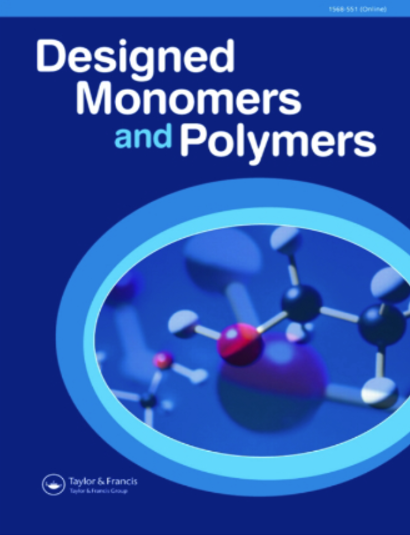双响应型聚(n -乙烯基己内酰胺-co- n -甲基丙烯酰胺)纳米凝胶的合成与表征
IF 2.3
4区 化学
Q3 POLYMER SCIENCE
引用次数: 0
摘要
摘要本文报道了聚(n -乙烯基己内酰胺-co- n -甲基丙烯酰胺)(P(NVCL-co-NMA))纳米凝胶的合成,并研究了其热/ ph响应行为。通过改变NVCL:NMA单体组成,采用自由基乳液聚合法合成纳米凝胶,并用1H-NMR和FTIR对其分子结构进行表征。结果表明,纳米凝胶制备成功,且表现出lcst型相变行为。通过紫外-可见分光光度计考察共聚物组成、MBA浓度和溶液pH的浊度变化,研究了云点转变温度(Tc)随溶液浊度变化的关系。我们的研究表明,Tc纳米凝胶随着NMA浓度的增加而增加,这是由于NMA的亲水性。我们的研究还表明,增加MBA的百分比可以降低合成的纳米凝胶的Tc。有趣的是,由于聚合物链内的氢键,P(NVCL-co-NMA)纳米凝胶在强酸性环境中不仅表现出热响应行为,而且随着Tc的增加也表现出pH响应。结果表明,初始单体组成分别为75%和25%的NVCL和NMA,添加4%的MBA的纳米凝胶在pH 7.4下,在35℃左右显示出Tc。此外,DLS研究也证实了这一结果,因为超过35℃后,颗粒尺寸变得更大。由于这一发现,这种纳米凝胶在控释方面可能具有潜在的应用前景。但是,对于Tc的调整,还需要进一步的研究。本文章由计算机程序翻译,如有差异,请以英文原文为准。
Synthesis and characterization of dual-responsive poly(N-vinylcaprolactam-co-N-methylolacrylamide) nanogels
ABSTRACT This article reports the synthesis of poly(N-vinylcaprolactam-co-N-methylolacrylamide) (P(NVCL-co-NMA)) nanogels and investigates their thermo-/pH-responsive behavior. The formation of nanogels was synthesized using free radical emulsion polymerization by varying the monomer composition of NVCL:NMA, and their molecular structure was characterized by 1H-NMR and FTIR. It was found that the nanogels were successfully prepared, and the nanogels exhibited LCST-type phase transition behavior. Cloud point transition temperature (Tc) was studied as a function of copolymer composition, MBA concentration, and pH of the solution by exploring their changes in turbidity using UV–vis spectrophotometer. Our studies reveal that Tc nanogels increased with increasing concentration of NMA, which is due to the hydrophilicity of NMA. Our research also demonstrated that the increase in MBA percentage could decrease the Tc of the synthesized nanogels. Interestingly, P(NVCL-co-NMA) nanogels showed not only a thermoresponsive behavior but also a pH response with increasing Tc in a strong acidic environment owing to the H-bonds within the polymer chains. The results show that nanogels with initial monomer composition of NVCL and NMA of 75% and 25%, respectively, and using 4% of MBA showed Tc around 35°C at pH 7.4. In addition, DLS studies also confirmed this result since the particle sizes became much larger after surpassing the temperature of 35°C. Due to this founding, such nanogels might have potential application in controlled release. Nevertheless, further studies regarding the adjustment of Tc are still needed.
求助全文
通过发布文献求助,成功后即可免费获取论文全文。
去求助
来源期刊

Designed Monomers and Polymers
化学-高分子科学
CiteScore
3.30
自引率
0.00%
发文量
28
审稿时长
2.1 months
期刊介绍:
Designed Monomers and Polymers ( DMP) publishes prompt peer-reviewed papers and short topical reviews on all areas of macromolecular design and applications. Emphasis is placed on the preparations of new monomers, including characterization and applications. Experiments should be presented in sufficient detail (including specific observations, precautionary notes, use of new materials, techniques, and their possible problems) that they could be reproduced by any researcher wishing to repeat the work.
The journal also includes macromolecular design of polymeric materials (such as polymeric biomaterials, biomedical polymers, etc.) with medical applications.
DMP provides an interface between organic and polymer chemistries and aims to bridge the gap between monomer synthesis and the design of new polymers. Submssions are invited in the areas including, but not limited to:
-macromolecular science, initiators, macroinitiators for macromolecular design
-kinetics, mechanism and modelling aspects of polymerization
-new methods of synthesis of known monomers
-new monomers (must show evidence for polymerization, e.g. polycondensation, sequential combination, oxidative coupling, radiation, plasma polymerization)
-functional prepolymers of various architectures such as hyperbranched polymers, telechelic polymers, macromonomers, or dendrimers
-new polymeric materials with biomedical applications
 求助内容:
求助内容: 应助结果提醒方式:
应助结果提醒方式:


